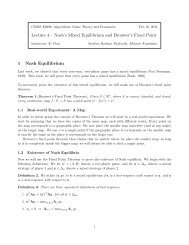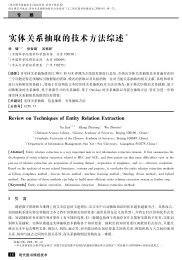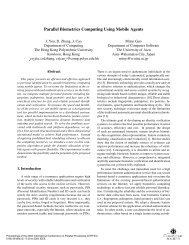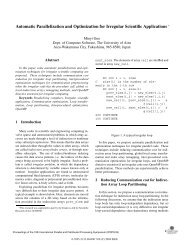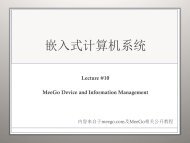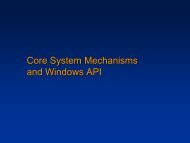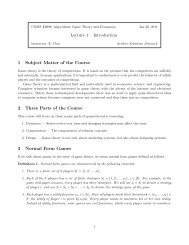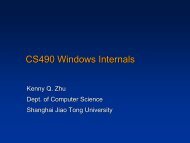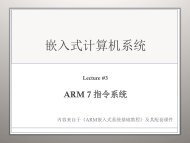PHED - Computer Science and Engineering
PHED - Computer Science and Engineering
PHED - Computer Science and Engineering
You also want an ePaper? Increase the reach of your titles
YUMPU automatically turns print PDFs into web optimized ePapers that Google loves.
<strong>PHED</strong>: Pre-H<strong>and</strong>shaking Neighbor Discovery<br />
Protocols in Full Duplex Wireless Ad Hoc Networks<br />
Guobao Sun, Fan Wu, Xiaofeng Gao, <strong>and</strong> Guihai Chen<br />
Shanghai Key Laboratory of Scalable Computing <strong>and</strong> Systems<br />
Department of <strong>Computer</strong> <strong>Science</strong> <strong>and</strong> <strong>Engineering</strong><br />
Shanghai Jiao Tong University, China<br />
sunguobao@sjtu.edu.cn, {fwu, gao-xf, gchen}@cs.sjtu.edu.cn<br />
Abstract—Neighbor Discovery (ND) is a basic <strong>and</strong> crucial<br />
step for initializing wireless ad hoc networks. A fast, precise,<br />
<strong>and</strong> energy-efficient ND protocol has significant importance to<br />
subsequent operations in wireless networks. However, many<br />
existing protocols have high probabilities to generate idle slots<br />
in their neighbor discovering processes, which extends the executing<br />
duration, <strong>and</strong> thus compromises their performance. In<br />
this paper, we propose a novel r<strong>and</strong>omized protocol <strong>PHED</strong>,<br />
Pre-H<strong>and</strong>shaking Neighbor Discovery Protocol, to initialize synchronous<br />
full duplex wireless ad hoc networks. By introducing<br />
a pre-communication strategy to help each node be aware of<br />
activities of its neighborhood, we significantly reduce the probabilities<br />
of generating idle slots <strong>and</strong> collisions. Moreover, with<br />
the development of single channel full duplex communication<br />
technology [1, 2], we further decrease the processing time needed<br />
in <strong>PHED</strong>, <strong>and</strong> construct the first full duplex neighbor discovery<br />
protocol. Our theoretical analysis proves that <strong>PHED</strong> can increase<br />
the speed of ND by approximately 98% in comparison with the<br />
classical ALOHA-like protocols [3, 4]. In addition, we provide<br />
several numerical experiments exhibiting the effectiveness of<br />
<strong>PHED</strong>.<br />
Index Terms—Wireless Ad Hoc Networks, Neighbor Discovery,<br />
Full Duplex Technology, R<strong>and</strong>omized Algorithm<br />
I. INTRODUCTION<br />
Wireless ad hoc networks have attracted a lot of interests<br />
from both academia <strong>and</strong> industry due to their wide range of<br />
applications. In many scenarios, nodes are deployed without<br />
the support of pre-existing infrastructures for communication.<br />
As a result, in a wireless ad hoc network nodes need to configure<br />
themselves through communication to form a reliable<br />
infrastructure as the initialization for further operations. For<br />
each node, the knowledge of its one-hop neighbors (the nodes<br />
it can directly communicate with) has significant importance<br />
to the upper layer protocols like MAC protocols, routing<br />
protocols, etc. Consequently, Neighbor Discovery (ND) is<br />
designed to discover a node’s one-hop neighbors <strong>and</strong> thus is<br />
momentous <strong>and</strong> crucial for configuring wireless networks.<br />
Compared with deterministic [9] <strong>and</strong> multi-user detectionbased<br />
[10] algorithms, r<strong>and</strong>omized algorithms are most commonly<br />
used to conduct neighbor discovery in wireless networks<br />
[3–8]. In those algorithms, each node transmits at different<br />
r<strong>and</strong>omly chosen time instants to reduce the possibility of<br />
the collision with other nodes. Usually, researchers discuss ND<br />
protocols under synchronous systems, <strong>and</strong> focus on a clique<br />
with n nodes, e.g., the famous Birthday Protocols [3]. In birthday<br />
protocols, at each single slot every node independently<br />
chooses to transmit discovery message by probability p <strong>and</strong><br />
listen by probability 1 − p (the optimal value of p is proved to<br />
be 1/n). By reducing the ND problem to Coupon Collector’s<br />
Problem [12], Vasudevan et al. [4] proved that the upper bound<br />
of expected time of birthday protocol is neH n , where H n is<br />
the n-th Harmonic number. Many subsequent researches on<br />
ND are based on birthday protocols. For example, the authors<br />
in [4] proposed solutions to scenarios for unknown neighbor<br />
numbers, asynchronous systems, <strong>and</strong> systems with reception<br />
status feedback mechanisms. Zeng et al. [5] discussed the<br />
performance of birthday protocols with multipacket reception<br />
(MPR). You et al. [8] discussed discovery time’s upper bound<br />
when nodes have a low duty-cycle.<br />
However, the family of birthday protocols has a vital drawback.<br />
The probability of an idle slot is p 0 = (1 − 1 n )n . When<br />
n = 10, p 0 ≈ 0.349. When n → +∞, p 0 → 1/e ≈ 0.368.<br />
Therefore when the number of nodes is large, the probability<br />
that no node transmits in a slot is about 37%. Furthermore,<br />
the probability of collisions also increases the iterations running<br />
in the protocols. For instance, two nodes transmitting<br />
simultaneously in a slot has a probability 1/(2e) ≈ 0.184,<br />
<strong>and</strong> three nodes transmitting simultaneously has a probability<br />
1/(6e) ≈ 0.06. 1 If we can effectively reduce the probabilities<br />
of collisions <strong>and</strong> idle slots, the performance will be<br />
tremendously ameliorated. Fortunately, with the development<br />
of full duplex wireless communication technology [1, 2], we<br />
can design better protocols if nodes can transmit <strong>and</strong> listen<br />
simultaneously in a single slot.<br />
Our key idea is twofold. On one h<strong>and</strong>, we introduce a preh<strong>and</strong>shaking<br />
strategy to help each node be aware of activities<br />
of its neighborhood before normal transmissions, such that<br />
the system can have higher probabilities to avoid collisions<br />
<strong>and</strong> idle slots. To achieve this pre-communication, we add<br />
some tiny sub-slots before each normal slot. With the help<br />
of full duplex technology, at each sub-slot every node will<br />
decide whether to transmit the message in a normal slot by<br />
broadcasting an anonymous election signal <strong>and</strong> catch its neighbors’<br />
signals simultaneously. With different sending-receiving<br />
scenarios, we design an effective strategy for each node to<br />
1 Lemma 1 in Section III proves that the probability of n nodes transmitting<br />
in a slot is 1/(n!e).
determine how to behave in normal slots. Correspondingly,<br />
we design the behaviors of each node in the normal slots to<br />
complete the ND process. On the other h<strong>and</strong>, a new reception<br />
status feedback mechanism is designed by using full duplex<br />
wireless radios. Originally in [6], a sub-slot is added after<br />
the normal slot <strong>and</strong> listeners will give feedback signals to<br />
transmitters in this sub-slot. In our design this overhead can<br />
be eliminated by using full duplex nodes. If a listener finds<br />
that two or more nodes are transmitting simultaneously, it<br />
will transmit a warning message immediately to inform other<br />
transmitters the failure of this transmission.<br />
Our contributions in this paper are listed as follows:<br />
• We design a novel ND protocol named <strong>PHED</strong> which<br />
st<strong>and</strong>s for Pre-H<strong>and</strong>shaking NEighbor Discovery, in<br />
which pre-h<strong>and</strong>shaking activities are inserted before normal<br />
communication. In <strong>PHED</strong> we avoid the vital drawback<br />
of the traditional birthday protocols <strong>and</strong> reduce the<br />
probabilities of collisions <strong>and</strong> idle slots. Other existing<br />
protocols based on birthday protocols can be ameliorated<br />
easily with our design, such as the ones proposed in [5, 8].<br />
• To the best of our knowledge, we are the first to consider<br />
the issue of ND with full duplex technology. For such<br />
a long time, researches of the ND problem in wireless<br />
networks are based on half duplex nodes. The import<br />
of full duplex technology enables nodes to transmit<br />
<strong>and</strong> receive simultaneously, which can be utilized to<br />
accelerate the ND process. Along with the emergence of<br />
full duplex technology, we can optimistically predict the<br />
transition from half duplex nodes to full duplex nodes,<br />
which implicates the significance of our design.<br />
The rest of this paper is organized as follows. Section II<br />
describes our model <strong>and</strong> assumptions. Section III introduces<br />
<strong>PHED</strong> <strong>and</strong> its theoretical analysis. In Section IV we evaluate<br />
<strong>PHED</strong> by simulation. In Section V we present related works.<br />
The paper concludes with our future works in Section VI.<br />
II. NETWORK MODEL AND ASSUMPTIONS<br />
In this section, we introduce the network model <strong>and</strong> several<br />
assumptions, under which we will present our <strong>PHED</strong> protocol<br />
<strong>and</strong> corresponding analysis. These assumptions are reasonable<br />
in the research of the ND <strong>and</strong> many former works are also<br />
based on the similar assumptions [3–5, 8]. Our assumptions<br />
are listed as follows:<br />
• Each node has a unique ID (e.g., the MAC address).<br />
• Time is identically slotted <strong>and</strong> nodes are synchronized on<br />
slot boundaries.<br />
• All nodes are in a clique of size n <strong>and</strong> n is known to all<br />
nodes in the clique.<br />
• Nodes use omnidirectional antennas, <strong>and</strong> all nodes have<br />
the same transmission range.<br />
• No MPR technique is used, i.e., a collision occurs when<br />
two or more nodes simultaneously transmit in a slot.<br />
• Nodes can listen <strong>and</strong> transmit on the same channel<br />
simultaneously.<br />
• Nodes can distinguish between collisions <strong>and</strong> idle slots.<br />
We also neglect possible errors caused by fading. So for two<br />
nodes A <strong>and</strong> B, if A transmits without collisions in a slot <strong>and</strong><br />
B is within the transmission range of A, then B can receive<br />
the packet without any error.<br />
III. <strong>PHED</strong>: PRE-HANDSHAKING PROTOCOL<br />
In this section we present our novel protocol <strong>PHED</strong> based<br />
on the assumptions in Section II, <strong>and</strong> analyze its performance<br />
theoretically. Firstly in Subsection III-A we add one tiny subslot<br />
before each normal slot <strong>and</strong> complete our design for<br />
the pre-h<strong>and</strong>shaking process. Next in Subsection III-B we<br />
extend our idea for the pre-h<strong>and</strong>shaking process by introducing<br />
more sub-slots before the normal slot <strong>and</strong> design the corresponding<br />
variation of <strong>PHED</strong>. Additionally in Subsection III-C<br />
we discuss in detail how many sub-slots should be used for<br />
the pre-h<strong>and</strong>shaking process to achieve the best performance.<br />
Moreover, in Subsection III-D we extend our discussion to the<br />
situation when n is unknown to nodes. Finally, in Subsection<br />
III-E we give the extension of <strong>PHED</strong> for multi-hop networks.<br />
A. <strong>PHED</strong> with Single Sub-Slot for Pre-H<strong>and</strong>shaking<br />
As mentioned in Section I, for each normal slot we insert<br />
a sub-slot before it to perform the pre-h<strong>and</strong>shaking process.<br />
We name this combination as an iteration. (It can also be<br />
considered as a “big slot”.) Let GR be the greeting process<br />
<strong>and</strong> TR be the transmission process in one iteration. Note that<br />
the length of a sub-slot can be as short as 1 bit since we do<br />
not care what a node transmits <strong>and</strong> only need to know whether<br />
the signals exist or not. The authors in [4] also adopted<br />
this assumption. Let M s be such kind of messages, which<br />
means an anonymous election signal with short duration. The<br />
normal slot is used to exchange discovery messages which may<br />
contain nodes’ IDs or MAC addresses. The size of a sub-slot is<br />
significantly smaller than that of a normal slot ([14] mentioned<br />
that the size of a slot can be about 10 Bytes.) <strong>and</strong> thus the<br />
overhead caused by sub-slots is almost negligible. We define<br />
this kind of discovery messages as M d .<br />
Fig. 1 illustrates the combination of sub-slots <strong>and</strong> normal<br />
slots. In Fig. 1 (a), we insert one sub-slot for one normal slot<br />
while in Fig. 1 (b) we insert multiple sub-slots before one<br />
normal slot to further increase the probability of successful<br />
transmissions <strong>and</strong> we will mention it in Subsection III-B.<br />
We are now ready to present our <strong>PHED</strong> protocol to determine<br />
the action of a node in a slot. <strong>PHED</strong> is a distributed<br />
protocol <strong>and</strong> for each node the target is to discover all its<br />
(a)<br />
(b)<br />
Sub-Slot<br />
Sub-Slots<br />
Normal Slot<br />
GR<br />
TR<br />
Normal Slot<br />
Iteration 1 Iteration 2 time<br />
Normal Slot<br />
Iteration 1<br />
GR<br />
TR<br />
Normal Slot<br />
Iteration 2<br />
Fig. 1: The description of an iteration.<br />
time
neighbors after finite iterations. Assume that we are considering<br />
a clique of n nodes. We divide <strong>PHED</strong> into two subroutines:<br />
<strong>PHED</strong>-GR <strong>and</strong> <strong>PHED</strong>-TR.<br />
Let us describe the main idea of <strong>PHED</strong>-GR: the preh<strong>and</strong>shaking<br />
process. At the beginning of a sub-slot, each node<br />
should determine its action in the following normal slot. The<br />
purpose is to find a subset of nodes in the network to send<br />
M d without collisions. Alg. 1 describes the detail of <strong>PHED</strong>-<br />
GR. Note that each node should run a copy of <strong>PHED</strong>-GR. To<br />
simplify our description, assume that we run <strong>PHED</strong>-GR on<br />
node A. Recall that M s is the election signal <strong>and</strong> M d is the<br />
discovery message. Define A f as a flag variable to indicate<br />
whether A has successfully sent M d . If A f = 0 then A has<br />
to send M d successfully in one of the following iterations,<br />
else A will keep silent <strong>and</strong> only receive messages. Initially<br />
A f = 0. Define A n as the number of undiscovered neighbors<br />
of A. Initially A n should be n − 1 <strong>and</strong> we let A n = n for the<br />
simplicity of later discussion.<br />
Algorithm 1 <strong>PHED</strong>-GR (Pre-H<strong>and</strong>shaking)<br />
1: if A f = 1 then ⊲ A has successfully sent M d .<br />
2: A will keep silent in TR <strong>and</strong> exit.<br />
3: end if<br />
4: Node A decides to send M s by probability 1/A n <strong>and</strong> keep<br />
listening by probability 1 − 1/A n .<br />
5: if A sends M s then ⊲ A hopes to send M d in TR.<br />
6: if A does not receive M s during GR then<br />
7: A will transmit M d in TR;<br />
8: else ⊲ A receives M s from other nodes<br />
9: A will transmit M d in TR by probability 1/2.<br />
10: end if<br />
11: else ⊲ A does not send M s<br />
12: if A does not receive M s during GR then<br />
13: A will transmit M d in TR by probability 1/A n ;<br />
14: else ⊲ A receives M s from other nodes<br />
15: A will keep silent in TR.<br />
16: end if<br />
17: end if<br />
In <strong>PHED</strong>-GR, each node decides to send M s by probability<br />
1/A n or keep silent by probability 1 − 1/A n . (The values of<br />
probabilities are chosen to be optimal according to [3].) Next<br />
we face two cases:<br />
1) If A sends an M s (Line 5-10), it implies A hopes to<br />
send M d in TR.<br />
a) At this moment, if A does not receive M s during<br />
GR, it means A wins the election <strong>and</strong> will definitely<br />
send M d in the following TR.<br />
b) If A receives M s . It means there exist other<br />
c<strong>and</strong>idates within A’s direct communication range.<br />
Therefore A can only send M d by probability 1/2.<br />
(We will explain the reason of setting probability<br />
1/2 after the proof of Lemma 1.)<br />
2) If A does not send M s (Line 11-17), it implies that A<br />
hopes to keep silent in the following TR.<br />
a) At this moment, if A does not receive M s in GR,<br />
it means no nodes decide to send M d in TR. A<br />
will reconsider sending M d by probability 1/A n .<br />
b) If A receives M s . It means that there are nodes<br />
intending to transmit <strong>and</strong> thus A will keep silent.<br />
When <strong>PHED</strong>-GR is finished, we enter the TR <strong>and</strong> start the<br />
process of neighbor discovering. Next we run <strong>PHED</strong>-TR: the<br />
neighbor discovering process, <strong>and</strong> the detailed description is<br />
shown in Alg. 2.<br />
Algorithm 2 <strong>PHED</strong>-TR (Neighbor Discovering)<br />
1: if A plans to send M d then<br />
2: A sends M d <strong>and</strong> monitors the channel meanwhile.<br />
3: if A does not receive M d during TR then<br />
4: A f = 1. ⊲ A will keep silent from now on<br />
5: else ⊲ A receives M d from other nodes<br />
6: Current iteration is invalid.<br />
7: end if<br />
8: else ⊲ A does not plan to send M d<br />
9: A keeps listening.<br />
10: if A does not receive M d during TR then<br />
11: Current iteration is invalid.<br />
12: else if A receives a single M d then<br />
13: Record the ID in M d .<br />
14: A n = A n − 1. ⊲ A records one of its neighbors.<br />
15: else ⊲ There is a collision at A<br />
16: Current iteration is invalid.<br />
17: end if<br />
18: end if<br />
In <strong>PHED</strong>-TR, there are two scenarios:<br />
1) If A sends M d , A will meanwhile check the existence<br />
of other signals (Line 1-7).<br />
a) If A does not receive M d during TR, it means<br />
that A’s transmission is successful. Consequently<br />
A will keep silent during the rest of ND process.<br />
b) If A receives M d from other nodes, it means that<br />
the current transmission is failed.<br />
2) If A does not send M d , A will check the number of<br />
transmitters (Line 8-18).<br />
a) If A does not receive M d during TR, it implies that<br />
no nodes send M d in TR. Therefore the current<br />
iteration is invalid.<br />
b) If A receives a single M d during TR, it means that<br />
there is one node successfully transmitting its M d .<br />
A will record the ID in M d <strong>and</strong> decrease the value<br />
of A n by 1.<br />
c) If there is a collision at A, it means that the current<br />
transmission is failed.<br />
We will keep running <strong>PHED</strong>-GR <strong>and</strong> <strong>PHED</strong>-TR in turn until<br />
A n = 1. Now we finish the description of <strong>PHED</strong> <strong>and</strong> start the<br />
discussion about the performance of this protocol.<br />
We denote the probability that a node successfully transmits<br />
its M d without collisions in TR as P 1 . We now begin to
analyze the expected time needed to discover all nodes with<br />
high probability with two lemmas.<br />
Lemma 1. When all nodes independently transmit by probability<br />
1/n, the probability that k nodes transmit simultaneously<br />
in a single slot is given by p k = 1 while n → +∞.<br />
k!e<br />
Proof: Since nodes choose their actions independently,<br />
the probability that k nodes transmit simultaneously in a slot<br />
with clique size n is given by p n,k = ( )<br />
n<br />
k (<br />
1<br />
n )k (1 − 1 n )n−k .<br />
When n → +∞, we use Poisson distribution to replace<br />
Binomial distribution. Hence, p k = lim p n,k = e−λ λ k<br />
n→+∞ k!<br />
with<br />
λ = n · 1<br />
n<br />
= 1. Thus the result holds.<br />
From Lemma 1 we can see that the probability that 3 or<br />
more nodes transmit simultaneously in a sub-slot is so small<br />
that it is acceptable to ignore it <strong>and</strong> assume that there are only<br />
2 nodes transmitting when the collision occurs to simplify the<br />
design of <strong>PHED</strong> since it is hard <strong>and</strong> also unnecessary to infer<br />
the exact number of transmitting nodes, which explains the<br />
Line 9 in Alg. 1.<br />
Lemma 2. (1 − 1 n )n−1 ≥ 1 , ∀n = 2, 3, . . .<br />
e<br />
This lemma is just the same as Lemma 1 in [4].<br />
We then use these two lemmas to evaluate the probability<br />
of a successful discovery in an iteration.<br />
Theorem 1. When there are n nodes in a clique <strong>and</strong> all nodes<br />
run <strong>PHED</strong>, the probability that a node successfully transmits<br />
M d in TR is bounded by<br />
Furthermore, when n → +∞,<br />
P 1 ≥ 1 e 2 (1 − 1 n ) + 5 4e<br />
P 1 ≥ 1 e 2 + 5 (2)<br />
4e<br />
Proof: We analyze different events which may occur in<br />
GR. If no one sends M s in GR, all nodes will reconsider their<br />
actions. The successful event’s (only one node transmits in<br />
TR) probability is<br />
p 0 = (1 − 1 n )n ( n<br />
1) 1<br />
n (1 − 1 n )n−1 = (1 − 1 n )2n−1 (3)<br />
If there is exactly one node sending a signal in GR, no<br />
collisions will occur in TR. Therefore the probability is<br />
( ) n 1<br />
p 1 =<br />
1 n (1 − 1 n )n−1 = (1 − 1 n )n−1 (4)<br />
If there are at least two nodes transmitting signals in GR,<br />
each node will transmit its M d with probability 1/2. Thus the<br />
successful event’s probability is<br />
n∑<br />
( n<br />
p 2 = (<br />
k)<br />
1 n )k (1 − 1 n )n−k · k · 1<br />
2 (1 − 1 2 )k−1<br />
k=2<br />
n∑<br />
( n<br />
= (<br />
k)<br />
1 n )k (1 − 1 k n )n−k 2 k (5)<br />
k=2<br />
(1)<br />
Obviously, P 1 = p 0 + p 1 + p 2 . Together with Lemma 2, we<br />
can get the following inequalities.<br />
p 0 = (1 − 1 n )2n−2 (1 − 1 n ) ≥ 1 e 2 (1 − 1 n ); p 1 ≥ 1 e ; (6)<br />
p 2 ≥<br />
( n<br />
2)<br />
( 1 n )2 (1 − 1 n )n−2 2 2 2 = 1 4 (1 − 1 n )n−1 ≥ 1 4e<br />
As a result, the theorem holds. The derivation of Inequality<br />
(2) is trivial hence we omit it.<br />
According to Theorem 1, P 1 ≥ 0.572 when n = 10 <strong>and</strong><br />
1<br />
when n = 20, P 1 ≥ 0.584. Note that<br />
e 2 + 5 ≈ 0.595. For<br />
4e<br />
simplicity, we will regard the Inequality (2) as an equation in<br />
our later discussion, i.e., P 1 = 0.595.<br />
We can see that the probability is significantly improved in<br />
comparison with the probability 1/e derived in [4].<br />
B. Recursive Protocol: <strong>PHED</strong>-tGR<br />
To further improve the successful transmission probability,<br />
we introduce more sub-slots in GR before TR in one iteration.<br />
In Subsection III-A, the probability of an idle slot is (1 −<br />
1<br />
n )2n ≈ 1 ≈ 0.135. It is still too high in practice, although<br />
e2 we have significantly reduced it. Thus we add more sub-slots<br />
to reduce this probability. We now give <strong>PHED</strong>-tGR (t ≥ 2)<br />
with t sub-slots in GR <strong>and</strong> describe it in Alg. 3.<br />
In <strong>PHED</strong>-tGR, A t is the local counter for each node to<br />
identify the current sub-slot in GR. Initially A t = 0, <strong>and</strong> after<br />
one round of <strong>PHED</strong>-tGR, A t will increase by 1. The maximum<br />
value of A t is t. Because of the synchronization assumption,<br />
in each node the local A t remains the same in each round.<br />
<strong>PHED</strong>-tGR is very similar to <strong>PHED</strong>-GR except in two<br />
aspects. The first is from Line 1 to 5, in which we put t<br />
Algorithm 3 <strong>PHED</strong>-tGR (Multiple Pre-H<strong>and</strong>Shaking)<br />
1: if A t = t then ⊲ <strong>PHED</strong>-tGR has run t times.<br />
2: A will keep silent in TR <strong>and</strong> exit.<br />
3: else ⊲ Still processing in t sub-slots<br />
4: A t = A t + 1.<br />
5: end if<br />
6: if A f = 1 then ⊲ A has successfully sent M d before.<br />
7: A will keep silent in TR <strong>and</strong> exit.<br />
8: end if<br />
9: A decides to send M s by probability 1/A n .<br />
10: if A sends an M s then<br />
11: if A does not receive M s during GR then<br />
12: A will transmit M d in TR;<br />
13: else ⊲ A receives M s from other nodes<br />
14: A will transmit M d in TR by probability 1/2.<br />
15: end if<br />
16: else ⊲ A does not send an M s<br />
17: if A does not receive M s during GR then<br />
18: Call <strong>PHED</strong>-tGR <strong>and</strong> exit.<br />
19: else ⊲ A receives M s from other nodes<br />
20: A will keep silent in TR.<br />
21: end if<br />
22: end if<br />
(7)
sub-slots in GR to achieve a higher probability of successful<br />
transmissions. The other one is at Line 18, in which <strong>PHED</strong>tGR<br />
invokes itself recursively to utilize the remaining sub-slots<br />
in GR. By using this recursive strategy, we can further reduce<br />
the probability of idle slots.<br />
We denote the successful event’s occurrence in <strong>PHED</strong>-tGR<br />
as P t <strong>and</strong> now we analyze the performance of <strong>PHED</strong>-tGR.<br />
Theorem 2. P t+1 is bounded by<br />
Slots needed<br />
120<br />
100<br />
80<br />
60<br />
40<br />
20<br />
Theoretical Value<br />
Linear Fit<br />
ALOHA−like Protocol<br />
P t+1 ≥ P t<br />
e (1 − 1 n ) + 5 4e<br />
where P 1 is given by Theorem 1.<br />
Proof: If there are t+1 sub-slots in GR, we again analyze<br />
different events which may occur in GR. If no one sends<br />
signal in GR, all nodes will invoke Alg. 3 recursively. Thus<br />
the successful event’s probability is<br />
p 0 = (1 − 1 n )n · P t ≥ P t<br />
e (1 − 1 n ) (9)<br />
The other two scenarios are just the same as the proof in<br />
Theorem 1. According to the Inequality (6), (7) <strong>and</strong> (9),<br />
P t+1 ≥ P t<br />
e (1 − 1 n ) + 5 4e<br />
Similarly, for simplicity we get<br />
P t+1 = P t<br />
e + 5 4e<br />
as n → +∞.<br />
We then point out the upper bound of P t .<br />
Theorem 3. lim P 5<br />
t =<br />
t→+∞ 4(e − 1) ≈ 0.727<br />
(8)<br />
(10)<br />
(11)<br />
This result can be derived by using the Equation (11)<br />
trivially, hence we omit the proof.<br />
We can see that the probability of a successful transmission<br />
in a slot is increased by approximately 98% compared with<br />
the probability 0.368 in the algorithm proposed in [4].<br />
C. Proper Number of Sub-Slots<br />
We have proved that the probability of a successful transmission<br />
can be significantly increased if there are sufficient<br />
sub-slots for nodes to detect other nodes’ actions. Nevertheless<br />
it is impossible to introduce infinite sub-slots in GR, we now<br />
discuss how to select a proper number of sub-slots in GR.<br />
Let us consider the Algorithm <strong>PHED</strong>-3GR. We can get the<br />
lower bound of P 3 due to Theorem 1 <strong>and</strong> 2 as follows:<br />
P 3 ≥ 1 e 4 (1 − 1 k )3 + 5<br />
4e 3 (1 − 1 k )2 + 5<br />
4e 2 (1 − 1 k ) + 5 4e (12)<br />
where k st<strong>and</strong>s for the number of nodes to be discovered at<br />
the current iteration. We can get lim P 3 ≈ 0.710. It is quite<br />
k→+∞<br />
close to the optimal value so it is feasible to introduce only<br />
three sub-slots before TR. Now we discuss the expected value<br />
<strong>and</strong> upper bound of slots needed to discover all n nodes.<br />
Theorem 4. By using <strong>PHED</strong>-3GR <strong>and</strong> <strong>PHED</strong>-TR, the expected<br />
value of slots needed to discover all nodes with high<br />
probability is 1.5n.<br />
0<br />
0 10 20 30 40<br />
Clique size<br />
Fig. 2: The comparison among the exact values of <strong>PHED</strong>, the linear fitting,<br />
<strong>and</strong> the performance of [4] (ALOHA-like Protocol).<br />
Proof: We assume that the discovery process is divided<br />
into epochs, <strong>and</strong> each epoch consists of at least one slot. Epoch<br />
i starts when the i-th node is discovered <strong>and</strong> terminates when<br />
the (i + 1)-th node is discovered. Let T i denote the number of<br />
slots of epoch i <strong>and</strong> T i is a geometrically distributed variable<br />
with parameter P 3 with k = n − i (There are n − i nodes to<br />
be discovered in epoch i). Hence,<br />
n∑<br />
n∑ 1<br />
E[T ] = E[T k ] = ≈ 1.5n (13)<br />
P 3<br />
k=1<br />
k=1<br />
where the last approximation comes from the result of the<br />
linear fitting since it is non-trivial to derive an exact upper<br />
bound of the summation.<br />
Fig. 2 shows the expected values of time slots needed to<br />
discover all nodes in different sizes of cliques in <strong>PHED</strong>. We<br />
can see that the linear fitting is quite close to the theoretical<br />
values of <strong>PHED</strong> <strong>and</strong> the time used is significantly decreased<br />
in comparison with [4].<br />
We next point out the upper bound of the time slots needed<br />
to discover all nodes with high probability.<br />
Theorem 5. By using <strong>PHED</strong>-3GR <strong>and</strong> <strong>PHED</strong>-TR, all nodes<br />
can be discovered in 3n slots with high probability.<br />
Proof: Since P 3 varies little as k changes, we regard P 3<br />
as a constant 1/1.5 = 2/3 for simplicity according to (13).<br />
Thus T is a sum of n independent <strong>and</strong> identically distributed<br />
Geometric r<strong>and</strong>om variables, <strong>and</strong> this distribution’s parameter<br />
is p = 2/3. As a result, T is a negative binomial r<strong>and</strong>om<br />
variable with parameters n <strong>and</strong> p = 2/3.<br />
The probability mass function is:<br />
( ) t − 1<br />
P (T = t) = p n (1 − p) t−n , t = n, n + 1, . . . (14)<br />
n − 1<br />
On the other h<strong>and</strong>, the following equation holds:<br />
P (T > t) = P (X < n), X ∼ Binomial(t, p) (15)<br />
Furthermore, Chernoff bounds point out that:<br />
P (X < (1 − δ)tp) < e −tpδ2 /2 , 0 < δ ≤ 1 (16)<br />
The formal proof of this inequality can be found in [12]. Then<br />
we substitute δ = 1 − n/tp into (16):<br />
P (T > t) = P (X < n) < e −tp<br />
2 (1− n tp )2 (17)
Slots needed<br />
300<br />
250<br />
200<br />
150<br />
100<br />
50<br />
Simulation Result<br />
Expected Value<br />
Upper Bound<br />
0<br />
0 20 40 60 80 100<br />
Clique size<br />
Fig. 3: Neighbor Discovery Time<br />
in Clique for <strong>PHED</strong><br />
Slots needed<br />
700<br />
600<br />
500<br />
400<br />
300<br />
200<br />
100<br />
<strong>PHED</strong><br />
Upper Bound<br />
ALOHA−like Protocol<br />
0<br />
0 20 40 60 80 100<br />
Clique size<br />
Fig. 4: Comparison of Neighbor<br />
Discovery Time in Clique<br />
Therefore we can get P (T > 3n) < e − n 4 . It is clear that<br />
e − n 4 → 0 for sufficiently large n. So the ND process can be<br />
finished in 3n slots with high probability.<br />
D. Unknown Number of Neighbors<br />
We now discuss the situation when n is unknown to nodes.<br />
We divide the process of discovery into phases. In phase<br />
i, each node runs the protocol with parameter n = 2 i , which<br />
means that we assume there are 2 i nodes in phase i. This phase<br />
lasts ⌈1.5·2 i ⌉ slots. As a result, in the ⌈log 2 n⌉-th phase, each<br />
node regards the number of nodes as n <strong>and</strong> this phase lasts<br />
about 1.5n slots. This is just the expected value which we<br />
have derived in the Subsection III-C.<br />
⌈log<br />
∑ 2 n⌉<br />
The total time needed is E[T ] = 1.5 · 2 m . Since we<br />
know that<br />
⌈log<br />
∑ 2 n⌉<br />
m=1<br />
m=1<br />
2 m = 2n − 2, the total time is<br />
E[T ] ≈ 3(n − 1) (18)<br />
Hence, the lack of knowledge of n results in about a factor<br />
of two slowdown when n is relatively large.<br />
E. Extension for Multi-Hop Networks<br />
<strong>PHED</strong> can be extended to work in multi-hop wireless<br />
networks, in which we must compete with the hidden terminal<br />
problem. In <strong>PHED</strong>, transmitters do not detect the collision<br />
themselves <strong>and</strong> nodes that are in receiving mode will detect<br />
collisions. If a receiver has detected the collision in TR, it will<br />
send a feedback signal immediately. In this way transmitters<br />
will know their transmissions are failed.<br />
Although the hidden terminal problem has a great impact<br />
on <strong>PHED</strong>’s performance, in Section IV we will show by<br />
simulation that <strong>PHED</strong> still has much better performance in<br />
a multi-hop network than the ALOHA-like protocol.<br />
A. Simulation Setup<br />
IV. PERFORMANCE EVALUATION<br />
Our simulation includes two kinds of settings: network <strong>and</strong><br />
clique. The network setting is a 300m×300m 2D plane <strong>and</strong><br />
nodes are put into the plane according to a uniform distribution.<br />
The nodes have the same transmission range 50m. There<br />
are various clique settings in our simulation. Considering the<br />
usual settings of wireless networks, we simulate the discovery<br />
process in a clique of 2 nodes to 100 nodes. It can be seen<br />
from the previous sections that the more nodes are deployed in<br />
a clique, the better <strong>PHED</strong>’s performance will be. Furthermore,<br />
we also simulate the situation in a multi-hop network.<br />
Nodes discovered<br />
50<br />
45<br />
40<br />
35<br />
30<br />
25<br />
20<br />
15<br />
10<br />
5<br />
ALOHA−like Protocol<br />
<strong>PHED</strong><br />
0<br />
0 50 100 150 200 250 300<br />
Time used<br />
Fig. 5: Comparison of Discovered<br />
Node Numbers in Clique<br />
Nodes discovered<br />
200<br />
180<br />
160<br />
140<br />
120<br />
100<br />
80<br />
60<br />
40<br />
20<br />
ALOHA−like Protocol<br />
<strong>PHED</strong><br />
0<br />
0 50 100 150 200 250 300<br />
Time used<br />
Fig. 6: Comparison of Discovered<br />
Node Numbers in Network<br />
We compare <strong>PHED</strong> with the ALOHA-like protocol with the<br />
feedback mechanism proposed in [4]. The advantage of having<br />
a feedback mechanism has already been shown in [4, 6]. Thus<br />
we will not compare <strong>PHED</strong> with protocols which do not have<br />
such mechanisms. Each data point in the figures st<strong>and</strong>s for an<br />
average result over 20 runs for accuracy.<br />
B. Simulation Results<br />
1) Validation of Theoretic Upper Bound: We now use<br />
simulation to validate the theorems stating that the expected<br />
value of time slots needed is 1.5n <strong>and</strong> the upper bound is 3n.<br />
Fig. 3 shows the number of slots needed to discover all<br />
nodes in different sizes of cliques. Three kinds of values are<br />
compared: the simulation results, the expected values <strong>and</strong> the<br />
upper bounds <strong>and</strong> we can see that the simulation results are<br />
larger than the corresponding expected values. This is mainly<br />
because when we simulate the discovery process, we regard<br />
a value as an output only when all nodes can be discovered<br />
in the time given in 20 consecutive runs. Nevertheless, the<br />
simulation results are still smaller than the upper bounds we<br />
derived, which proves the correctness of our derivation.<br />
2) Comparison in Clique: Similarly we analyze the performance<br />
of <strong>PHED</strong> with the ALOHA-like protocol. For a certain<br />
clique size, a time threshold can be regarded as an exact value<br />
only when all nodes are discovered in consecutive 20 runs.<br />
Fig. 4 shows the comparison between two protocols with<br />
different sizes of cliques. We can see that <strong>PHED</strong> significantly<br />
reduces the processing time, so as the upper bound estimation.<br />
When there are 100 nodes in a clique, it takes more than 600<br />
slots to finish ND process by ALOHA-like protocol, whereas<br />
<strong>PHED</strong> only uses 300 slots to finish the process.<br />
We must point out that the definitions of a slot are slightly<br />
different in these two protocols. In <strong>PHED</strong> there are three tiny<br />
sub-slots before the normal slot while in [4] there are one subslot<br />
after the normal slot. Because the duration of sub-slots is<br />
really short, (We have mentioned it in Section III.) we can<br />
still compare two protocol’s performance by comparing their<br />
consumption of time slots.<br />
Fig. 5 shows the trend of the number of discovered nodes in<br />
a clique with increasing number of iterations. We can see that<br />
ND is almost finished after 100 slots in <strong>PHED</strong> while it costs<br />
about 200 slots in ALOHA-like protocol. These observations<br />
can also be found in Fig. 3 <strong>and</strong> Fig. 4.<br />
3) Comparison in Multi-Hop Network: We also evaluate the<br />
performance of <strong>PHED</strong> <strong>and</strong> the ALOHA-like protocol under the<br />
network environment. We put 200 nodes to the plane <strong>and</strong> the<br />
average number of neighbors for a certain node is about 18.
Fig. 6 shows that the number of discovered nodes in a<br />
network is increasing with the number of iterations. We can<br />
know that after 150 slots, almost all 200 nodes are discovered<br />
by <strong>PHED</strong>, whereas it takes about 300 slots to discover all<br />
nodes by the ALOHA-like protocol.<br />
Due to the existence of the hidden terminal, the time<br />
needed to discover all nodes in a multi-hop network is much<br />
larger than the time needed when there is only one clique.<br />
Nevertheless, <strong>PHED</strong> still significantly reduces the time needed<br />
in comparison with the ALOHA-like protocol.<br />
V. RELATED WORK<br />
A large number of works have focused on the problem of<br />
ND in wireless networks <strong>and</strong> various protocols have been<br />
proposed to adapt to different situations [3–11]. Due to the<br />
space limitation we mainly introduce several works with close<br />
relationship with <strong>PHED</strong>. Birthday protocols in [3] use a<br />
r<strong>and</strong>omized strategy for nodes in a synchronous system to<br />
choose their actions in a slot independently <strong>and</strong> r<strong>and</strong>omly.<br />
The authors proved that for a clique with n nodes, the optimal<br />
probability that a node transmits is 1/n.<br />
Vasudevan et al. [4] later pointed out that the expected<br />
time slots needed to finish ND process by using the birthday<br />
protocol in [3] is neH n where H n is the n-th Harmonic<br />
number. The authors also proposed protocols for more realistic<br />
situations where the size of a clique is unknown to nodes, a<br />
feedback mechanism is introduced into the system <strong>and</strong> the<br />
clocks of nodes are not identical, i.e., the system is asynchronous<br />
[7]. Basically, a factor of two slowdown is brought<br />
in if the size of a clique is unknown, while a factor of ln n<br />
slowdown is brought in if there are no feedback mechanisms.<br />
Zeng et al. [5] extended the result of [4] to the MPR<br />
situation where no collision occurs iff there are no more than<br />
k (k ≥ 2) nodes transmitting simultaneously <strong>and</strong> proved that<br />
the expected time needed to discover all nodes is Θ(n ln n/k).<br />
Ideally, if k ≥ n, the discover time is shortened to Θ(ln n).<br />
Similarly, the authors designed protocols for realistic situations<br />
in [4] <strong>and</strong> analyzed the upper bounds respectively.<br />
You et al. [8] extended the result of [4] to the situation when<br />
the duty cycle of nodes is not 1, i.e., some nodes may be<br />
dormant at a certain time instant. By reducing the problem to<br />
the generalization of the classical Coupon Collector’s Problem<br />
[13], the authors proved that when the duty cycle is 1/2, the<br />
upper bound is ne(log 2 n+(3 log 2 n−1) log 2 log 2 n+c) with<br />
a constant c <strong>and</strong> the lack of knowledge of n results in a factor<br />
of two slowdown as well in a clique.<br />
Many papers have focused on the feasibility of designing a<br />
practical full duplex wireless radio. Choi et al. [1] proposed a<br />
method named antenna cancellation to avoid self-interference.<br />
However, this technique requires three antennas, which makes<br />
it unattractive in comparison with a 3-antenna MIMO system<br />
with higher throughput. This method also suffers from the<br />
constraint of b<strong>and</strong>width seriously, which makes it not feasible<br />
for wideb<strong>and</strong> signals such as WiFi.<br />
Jain et al. [2] overcame the drawbacks of [1] <strong>and</strong> proposed a<br />
novel mechanism which is called balun cancellation, in which<br />
a balun circuit is used to create inverse signals to achieve the<br />
cancellation of self-interference. This method requires only<br />
two antennas <strong>and</strong> has no b<strong>and</strong>width constraints theoretically.<br />
Furthermore, the authors had made an experimental device<br />
which supports the signal channel full duplex communication.<br />
Though some realistic conditions make the device not as<br />
perfect as it is in theory, it is still safe to say that the single<br />
channel full duplex technology is promising <strong>and</strong> thus our work<br />
utilizes it to accelerate the ND process.<br />
VI. CONCLUSION AND FUTURE WORK<br />
In this paper, we proposed a pre-h<strong>and</strong>shaking neighbor<br />
discovery protocol <strong>PHED</strong> by adding pre-h<strong>and</strong>shaking sub-slots<br />
before the traditional slots. Furthermore, we applied the full<br />
duplex technology <strong>and</strong> used it to conduct pre-h<strong>and</strong>shaking<br />
with new feedback mechanisms. We analyzed the expected<br />
value <strong>and</strong> upper bound of ND processing time theoretically,<br />
<strong>and</strong> validated our analysis by simulation compared with the<br />
ALOHA-like protocol proposed in [4]. Both theoretical analysis<br />
<strong>and</strong> numerical experiments proved that <strong>PHED</strong> significantly<br />
decreases the time needed to finish the ND process.<br />
In the future, we would like to evaluate the performance<br />
of <strong>PHED</strong> by test-bed experiments. We also want to consider<br />
more realistic models, e.g., nodes with MPR techniques, nodes<br />
with low duty cycles <strong>and</strong> asynchronous models.<br />
REFERENCES<br />
[1] J. I. Choi, M. Jain, K. Srinivasan, P. Levis, <strong>and</strong> S. Katti. “Achieving<br />
Single Channel, Full Duplex Wireless Communication”. In Proc. of<br />
ACM MobiCom, 2010.<br />
[2] M. Jain, J. I. Choi, T. M. Kim, D. Bharadia, S. Seth, K. Srinivasan,<br />
P. Levis, S. Katti, <strong>and</strong> P. Sinha. “Practical, Real-time, Full Duplex<br />
Wireless”. In Proc. of ACM MobiCom, 301-312, 2011.<br />
[3] M. J. McGlynn <strong>and</strong> S. A. Borbash. “Birthday Protocols for Low Energy<br />
Deployment <strong>and</strong> Flexible Neighbor Discovery in Ad Hoc Wireless<br />
Networks”. In Proc. of ACM MobiHoc, 137-145, 2001.<br />
[4] S. Vasudevan, D. Towsley, D. Goeckel, <strong>and</strong> R. Khalili. “Neighbor<br />
Discovery in Wireless Networks <strong>and</strong> the Coupon Collector’s Problem”.<br />
In Proc. of ACM MobiCom, 181-192, 2009.<br />
[5] W. Zeng, X. Chen, A. Russell, S. Vasudevan, B. Wang, <strong>and</strong> W.<br />
Wei. “Neighbor Discovery in Wireless Networks with Multipacket<br />
Reception”. In Proc. of ACM MobiHoc, 3:1-10, 2011.<br />
[6] R. Khalili, D. Goeckel, D. Towsley, <strong>and</strong> A. Swami. “Neighbor Discovery<br />
with Reception Status Feedback to Transmitters”. In Proc. of IEEE<br />
INFOCOM, 2010.<br />
[7] S. A. Borbash, A. Ephremides, <strong>and</strong> M. J. McGlynn. “An Asynchronous<br />
Neighbor Discovery Algorithm for Wireless Sensor Networks”. Elsevier<br />
Ad Hoc Networks, 5(7): 998-1016, 2007.<br />
[8] L. You, Z. Yuan, P. Yang, <strong>and</strong> G. Chen. “ALOHA-Like Neighbor<br />
Discovery in Low-Duty-Cycle Wireless Sensor Networks”. In Proc.<br />
of IEEE WCNC, 749-754, 2011.<br />
[9] A. Keshavarzian <strong>and</strong> E. Uysal-Biyikoglu. “Energy-Efficient Link Assessment<br />
in Wireless Sensor Networks”. In Proc. of IEEE INFOCOM,<br />
2004.<br />
[10] D. Angelosante, E. Biglieri, <strong>and</strong> M. Lops. “Neighbor Discovery in<br />
Wireless Networks: A Multiuser-Detection Approach”. In Information<br />
Theory <strong>and</strong> Applications Workshop, 46-53, 2007.<br />
[11] Z. Zhang <strong>and</strong> B. L., “Neighbor Discovery in Mobile Ad Hoc Self-<br />
Configuring Networks with Directional Antennas: Algorithms <strong>and</strong><br />
Comparisons”. In IEEE TWC, (7)5:1540-1549, 2008.<br />
[12] R. Motwani <strong>and</strong> P. Raghavan. “R<strong>and</strong>omized Algorithms”. Cambridge<br />
University Press, 1995.<br />
[13] P. Erdös <strong>and</strong> A. Rényi. “On a Classical Problem of Probability Theory”.<br />
Magyar Tud. Akad. Mat. Kutato Int. Kozl, 1961.<br />
[14] L. Kong, L. Fu, X. Liu <strong>and</strong> M. Wu. “Accelerating Initialization for<br />
Sensor Networks”. In Proc. of IEEE GLOBECOM, 2009.




